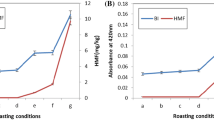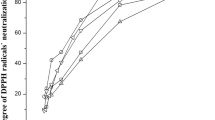Abstract
The present study focuses on the effect of temperature and extraction methods on the yields, chemical quality, fatty acids, and tocopherols of the oil extracted from the seeds of Opuntia ficus-indica, collected in the eastern region of Morocco. Our results revealed the effect of temperature that when we increase the temperature used, the yields also increase; the results also showed that this high temperature does not affect the physicochemical properties, fatty acids, and tocopherols. Thus, the results of this study revealed that the prickly pear is a rich source of oil; the obtained oil yields varied from 12.49%±0.09 for mechanical extraction, 11.46±0.10 for chemical extraction, and 10.52%±0.09 for maceration. The main fatty acids founded in Opuntia ficus-indica are linoleic acid 75.80%±0.10 (chemical), 74.07%±0.14 (maceration), and 71.59%±0.14 (mechanical) and palmitic acid 17.32%±0.02 (chemical), 22.419%±0.06 (maceration), and 26.58%±0.00 (mechanical); prickly pear oil could be classified as a linoleic acid. The physicochemical properties of Opuntia ficus-indica seed oils such as acid index mgKOH/g oil (4,376±0.10, 5.854±0.03, 5.667±0.07), saponification value mgKOH/g oil (181.12 ±0.18, 183.77±1.23, 179.08±3.45), and peroxide value 20milieq/Kg (5.75±0.08, 6±0.06, 5.97±0.04) for mechanical, chemical, and maceration extraction, respectively, density, and refractive index were all found to be in good accordance with quality criteria for both pure and fresh oils. Among the tocopherols found, a high value of γ-tocopherol was detected in mechanical extraction with 502.04±0.76 mg/kg, followed by chemical extraction and maceration with 430.12±0.61mg/kg and 315.47±0.96 mg/kg, respectively.
Graphical abstract




Similar content being viewed by others
Data availability
The datasets used and/or analyzed during the current study are available from the corresponding author on reasonable request.
References
AFNOR (2000) « Recueil de normes : les huiles essentielles. Tome 2. Monographies relatives aux huiles essentielles ». AFNOR, Paris, 661-663.
Ahmed MS, El Tanbouly ND, Islam WT, Sleem AA, EL Senousy AS (2005) Antiinflammatory flavonoids from Opuntia dillenii(ker-gawl) Haw. Flowers growing in Egypt. Phytotherapy Research: An Inter. J. Devoted. Pharm. Toxic. Eval Nat. Prod. Deriv 19(9):807–809. https://doi.org/10.1002/ptr.1708
Akpan UG, Jimoh A, Mohammed AD (2006) Extraction, characterization and modification of castor seed oil. Leonardo J. Sci 8(1):43–52
Al-Juhaimi F, Ghafoor K, Uslu N, Isam A.M Ahmed, Babiker E.E, Özcan M.M, Fadimu J.G (2019). The effect of harvest times on bioactive properties and fatty acid compositions of prickly pear (Opuntia ficus-barbarica A. Berger) fruits. Food Chemistry, (303), https://doi.org/10.1016/j.foodchem.2019.125387
Al-Juhaimi F, Özcan MM (2013) Determination of some mineral contents of prickly pear (Opuntia ficus-indica L.) seed flours. Environmental Monitoring and Assessment 185:3659–3663. https://doi.org/10.1007/s10661-012-2817-4
AOCS (1989) A.O.C.S. official method ce 8-89 determination of tocopherols and tocotrienols in vegetable oils and fats by HPLC. 5 pp. In: Official Methods and Recommended Practices of the American Oil Chemists’ Society 5th edition
Barba FJ, Putnik P, Kovačević DB, Poojary MM, Roohinejad S, Lorenzo JM, Koubaa M (2017) Impact of conventional and non-conventional processing on prickly pear (Opuntia spp.) and their derived products: From preservation of beverages to valorization of byproducts. Trends in food science & technology 67:260–270
Belviranlı, B., Al-Juhaimi, F., Özcan, M. M., Ghafoor, K., Babiker, E. E., & Alsawmahi, O.N. (2019). Effect of location on some physico-chemical properties of prickly pear (Opuntia ficus-indica L.) fruit and seeds. Journal of Food Processing and Preservation, 43, e13896. https://doi.org/10.1111/jfpp.13896.
Bouaouine O, Bourven I, Khalil F, Baudu M (2018) Identification of functional groups of Opuntia ficus-indica involved in coagulation process after its active part extraction. Env. Sci. Poll. Res 25(11):11111–11119. https://doi.org/10.1007/s11356-018-1394-7
Boukeloua A, Belkhiri A, Djerrou Z, Bahri L, Boulebda N, Pacha YH (2012) Acute toxicity of Opuntia ficus indica and Pistacia lentiscus seed oils in mice. African Journal of Traditional, Complementary and Alternative Medicines 9(4):607–611. https://doi.org/10.4314/ajtcam.v9i4.19
Brahmi F, Haddad S, Bouamara K, Yalaoui-Guellal D, Prost-Camus E, de Barros JPP, ... & Lizard G (2020). Comparison of chemical composition and biological activities of Algerian seed oils of Pistacia lentiscus L., Opuntia ficus indica (L.) mill. and Argania spinosa L. Skeels. Industrial Crops and Products, 151, 112456.
Chaaben H, Motri S, Ben Selma MZ (2015) Etude des Propriétés Physico-chimiques de l’Huile de Fruit de Laurus nobilis et Effet de la Macération par les Fruits et les Feuilles de Laurus nobilis sur les Propriétés Physico-Chimiques et la Stabilité Oxydative de l’Huile d’Olive. J. New Sci. Agric. Biotechnol. JS-INAT 8:873–880
Chaouch MA, Hafsa J, Rihouey C, Le Cerf D, Majdoub H (2016) Effect of pH during extraction on the antioxidant and antiglycated activities of polysaccharides from Opuntia ficus indica. Journal of Food Biochemistry 40(3):316–325. https://doi.org/10.1111/jfbc.12220
Coşkuner YN, Tekin A (2003) Monitoring of seed composition of prickly pear (Opuntia ficus-indica L) fruits during maturation period. J. Sci. Food. Agr 83(8):846–849. https://doi.org/10.1002/jsfa.1423
De Wit M, Hugo A, Shongwe N (2017) Quality assessment of seed oil from selected cactus pear cultivars (Opuntia ficus-indica and Opuntia robusta). Journal of food processing and preservation 41(3):e12898. https://doi.org/10.1111/jfpp.12898
El Hachimi F, El Antari A, Boujnah M, Bendrisse A, Alfaiz C (2015) Comparaison des huiles des graines et de la teneur en acides gras de différentes populations marocaines de jujubier, de grenadier et de figuier de barbarie [Comparison of oils seed and fatty acid content of various Moroccan populations of jujube, grenadier and prickly pear]. Journal of Materials and Environmental Science 6(5):1488–1502
El Hayek E, El Samrani A, Lartiges B, Kazpard V, Benoit M, Munoz M (2015) Potential of Opuntia ficus-indica for air pollution biomonitoring: a lead isotopic study. Env. Sci. Poll. Res 22(22):17799–17809
El Kossori RL, Villaume C, El Boustani E, Sauvaire Y, Méjean L (1998) Composition of pulp, skin and seeds of prickly pears fruit (Opuntia ficus indica sp.). Plant Foods for Human Nutrition 52(3):263–270. https://doi.org/10.1023/A:1008000232406
El Mannoubi I, Barrek S, Skanji T, Casabianca H, & Zarrouk H (2009). Characterization of Opuntia ficus indica seed oil from Tunisia. Chem. Nat. Comp, 45(5), 616. https://doi.org/10.1007/s10600-009-9448-1
Ennouri M, Fetoui H, Bourret E, Zeghal N, Attia H (2006) Evaluation of some biological parameters of Opuntia ficus indica. 1. Influence of a seed oil supplemented diet on rats. Bioresource Technology 97(12):1382–1386. https://doi.org/10.1016/j.biortech.2005.07.010
Ennouri M, Evelyne B, Laurence M, Hamadi A (2005) Fatty acid composition and rheological behaviour of prickly pear seed oils. Food Chemistry 93(3):431–437. https://doi.org/10.1016/j.foodchem.2004.10.020
Felker P, Soulier C, Leguizamón G, Ochoa J (2002) A comparison of the fruit parameters of 12 Opuntia clones grown in Argentina and the United States. Journal of Arid Environments 52(3):361–370. https://doi.org/10.1006/jare.2002.1001
Galati EM, Mondello MR, Giuffrida D, Dugo G, Miceli N, Pergolizzi S, Taviano MF (2003) Chemical characterization and biological effects of Sicilian Opuntia ficus indica (L.) Mill. Fruit juice: antioxidant and antiulcerogenic activity. Journal of Agricultural and Food Chemistry 51(17):4903–4908. https://doi.org/10.1021/jf030123d
Galati EM, Monforte MT, Tripodo MM, d'Aquino A, Mondello MR (2001) Antiulcer activity of Opuntia ficus indica (L.) Mill. (Cactaceae): ultrastructural study. Journal of Ethnopharmacology 76(1):1–9. https://doi.org/10.1016/S0378-8741(01)00196-9
Gharby S, Harhar H, Charrouf Z, Bouzobaa Z, Boujghagh M and Zine S (2015), Physicochemical composition and oxidative stability of Opuntia ficus-indica seed oil from Morocco,Physicochemical. J.Acta Horticulturae p :83-88. https://doi.org/10.17660/ActaHortic.2015.1067.11
Ghazi Z, ELmssellem H, Ramdani M, Chetouani A, Rmil R, Aouniti A et al (2014) Corrosion inhibition by naturally occurring substance containing Opuntia-ficus indica extract on the corrosion of steel in hydrochloric acid. J Chem Pharm Res 6:14171425
Kandji N (2001) Thèse pour l’obtention du titre de Docteur en Pharmacie. Université Cheik Anta Diop (UCAD) de Dakar, Sénégal
Lahsasni S, Kouhila M, Mahrouz M, Jaouhari JT (2004) Drying kinetics of prickly pear fruit (Opuntia ficus indica). J. Food. Eng 61(2):173–179. https://doi.org/10.1016/S0260-8774(03)00084-0
Lee J-C, Kim HR, Kim J (2002) Antioxidant property of an ethanol extract of the stem of Opuntia ficus-indica var. Saboten. J.Agricultural and Food Chemistry 50(22):6490–6496. https://doi.org/10.1021/jf020388c
Letawe C, Boone M, Piérard GE, Clin. Exp. Dermatol, Digital image analysis of the effect of topically applied linoleic acid on acne microcomedones 23 (2) (1998) 56-58. https://doi.org/10.1046/j.1365-2230.1998.00315.x
Livrea MA, Tesoriere L (2006) Health benefits and bioactive components of fruits from Opuntia ficus indica (L.) Mill. Journal of the Professional Association for Cactus Development 8:73–90
Maataoui BS, Hmyene A, Hilali S (2006) Activites antiradicalaires d’extraits de jus de fruits du figuier de barbarie [Opuntia ficus indica]. Lebanese science journal 7(1):3–8
Matthäus B, Özcan MM (2011) Habitat effects on yield, fatty acid composition and tocopherol contents of prickly pear (Opuntia ficus-indica L.) seed oils. Scientia Horticulturae 131:95–98. https://doi.org/10.1016/j.scienta.2011.09.027
Ollë M., 2002. Direction de la concurrence .de la consommation et de répression des fraudes interrégionales de Montpellier. Dossier P3325.Technique d’analyse. Vol papier n°: TA4
Özcan MM, Al Juhaimi FY (2011) Nutritive value and chemical composition of prickly pear seeds (Opuntia ficus indica L.) growing in Turkey. International journal of food sciences and nutrition 62(5):533–536. https://doi.org/10.3109/09637486.2011.552569
Quintanar-Orozco ET, Vázquez-Rodríguez GA, Beltrán-Hernández RI, Lucho-Constantino CA, Coronel-Olivares C, Montiel SG, Islas-Valdez S (2018) Enhancement of the biogas and biofertilizer production from Opuntia heliabravoana Scheinvar. Environmental Science and Pollution Research. 25:28403–28412. https://doi.org/10.1007/s11356-018-2845-x
R’bia O, Chkioua C, Hellal R, Herchi W, Smiti SA (2017) Antioxidant and antibacterial activities of Opuntia ficus indica seed oil fractions and their bioactive compounds dentification. Turkish Journal of Biochemistry 42(4):481–491. https://doi.org/10.1515/tjb-2016-0200
Ramadan MF, Mörsel JT (2003) Oil cactus pear (Opuntia ficus-indica L.). Food chemistry 82(3):339–345. https://doi.org/10.1016/S0308-8146(02)00550-2
Rasoulpour R, Afsharifar A, Izadpanah K (2018) Antiviral activity of prickly pear (Opuntia ficus-indica (L.) Miller) extract: opuntin B, a second antiviral protein. Crop Protection 112:1–9. https://doi.org/10.1016/j.cropro.2018.04.017
Sawaya WN, Khan P (1982) Chemical characterization of prickly pear seed oil, Opuntia ficus-indica. Journal of Food Science 47(6):2060–2061. https://doi.org/10.1111/j.1365-2621.1982.tb12946.x
Stintzing, F. C.; Schieber, A. and Carle, R. (1999). Cactus pear: a source of pigments and nutritionally important components. Annals of the 22nd IFU Symposium, Paris. pp. 349-365.
Taoufik F, Zine S, El Hadek M, Idrissi Hassani LM, Gharby S, Harhar H, Matthäus B (2015) Oil content and main constituents of cactus seed oils Opuntia Ficus Indica of different origin in Morocco. Mediterranean Journal of Nutrition and Metabolism 8(2):85–92. https://doi.org/10.3233/MNM-150036
Tlili N, Bargougui A, Elfalleh W, Triki S, Nasri N (2011) Phenolic compounds, protein, lipid content and fatty acids compositions of cactus seeds. Journal of Medicinal Plants Research 5(18):4519–4524
Acknowledgements
We thank all persons who contributed in the elaboration of this paper.
Author information
Authors and Affiliations
Contributions
SK performed the experiments and wrote the paper. AB is responsible for resources and figures. El HL and BH read and correct the paper. SF analyzed the data.
All the authors read and contributed to the submitted version of the manuscript.
Corresponding author
Ethics declarations
Ethics approval
Not applicable.
Consent for publication
All authors agree to publish.
Competing interests
The authors declare no competing interests.
Additional information
Responsible Editor: Philippe Garrigues
Publisher’s note
Springer Nature remains neutral with regard to jurisdictional claims in published maps and institutional affiliations.
Rights and permissions
About this article
Cite this article
Kadda, S., Belabed, A., Loukili, E.H. et al. Temperature and extraction methods effects on yields, fatty acids, and tocopherols of prickly pear (Opuntia ficus-indica L.) seed oil of eastern region of Morocco. Environ Sci Pollut Res 29, 158–166 (2022). https://doi.org/10.1007/s11356-021-16752-8
Received:
Accepted:
Published:
Issue Date:
DOI: https://doi.org/10.1007/s11356-021-16752-8




